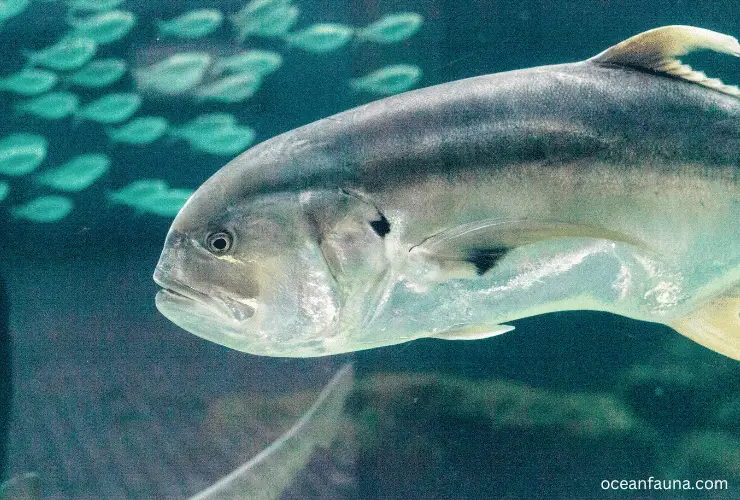The Jack Crevalle, also called the common jack, is a type of big ocean fish that belongs to the Carangidae family. It’s also known by other names such as black-tailed trevally, Cavalli Jack, Black Cavalli, and Yellow Cavalli.
Extensive studies have shown that this fish is a powerful, predatory fish that consumes a range of small fish. In addition, it feeds on invertebrates such as prawns, shrimps, crabs, mollusks, and cephalopods, although to a lesser extent.
You’re here to learn about Jack Crevalle’s habitat, diet, anatomy, lifespan, reproduction system, and conservation status. I will provide detailed explanations about each of these topics. Let’s begin!
About: Jack Crevalle [In Brief]
Jack Crevalle is a popular game fish that is found in the coastal waters of the western Atlantic Ocean, from Nova Scotia to Brazil.
The jack crevalle has a torpedo-shaped body that is designed for speed and agility in the water. It has a dark olive-green back, with silver sides and a white belly. It can grow up to 3 feet in length and can weigh up to 40 pounds.
These fish are found in a variety of habitats, including estuaries, bays, and shallow reefs. They are known to feed on a variety of prey, including small fish, crabs, and shrimp. Their feeding habits make them an important part of the food chain in their ecosystem.
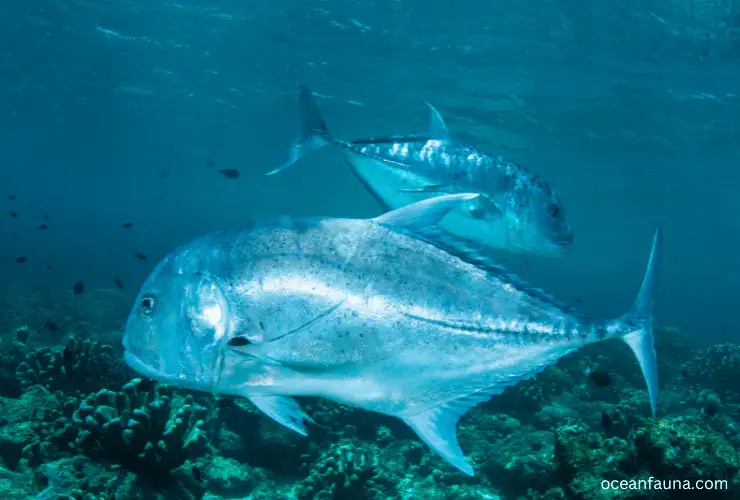
Jack Crevalle is known for their aggressive nature and strong fight. When hooked, they put up a fierce battle, often making long runs and jumps to try to escape. This makes them a popular target of recreational fishermen, who enjoy the challenge of catching these powerful fish.
| Category | Information |
| Scientific name | Caranx hippos |
| Other name | Common jack, black-tailed trevally, couvalli jack, crevalle jack, crevale, cavalla |
| Diet | Fish, shrimp, crabs, and cephalopods |
| Habitat | Shallow coastal waters, estuaries, lagoons, and bays |
| Length | Up to 4 feet |
| Lifespan | Around 10 years |
| Interesting Fact | Jack crevalle are known for their aggressive fighting behavior and are a popular target for sport fishing. They are also known to jump out of the water when hooked, making them a challenging catch for anglers. |
How Jack Crevalle Gets Its Name?
The jack crevalle, scientifically known as Caranx hippos, is a common fish species found in the warm waters of the Atlantic Ocean, the Gulf of Mexico, and the Caribbean Sea. The name “jack crevalle” is a derivative of the word “cavalla,” which dates back centuries and is believed to have originated from the Spanish word “caballa,” meaning horse mackerel.
The jack crevalle’s name comes from its resemblance to other fish in the jack family, with its elongated body, deep forked tail, and spiny dorsal fin.
However, its distinctive coloration sets the jack crevalle apart from other jacks. Jack crevalles have a silver to pale green base color, often with dark blotches on their upper body and a yellow tint to their fins.
While the exact origins of the term “cavalla” remain uncertain, it is clear that it has been used to describe various species of jacks for centuries, including the jack crevalle. This name is still used in scientific and common contexts today to refer to the species.
Jack Crevalle’s name isn’t its only connection to horses. These fast-swimming fish are known to jump out of the water like a running horse leaping over an obstacle. They are also known for their powerful swimming abilities, making them a popular game and sport fish for anglers.
Anatomy of Jack Crevalle
The Jack Crevalle, scientifically known as Caranx hippos, is a popular saltwater fish found in warm coastal waters across the world. Jack Crevalle is known for its strength and fast movements, making it a challenging catch for anglers.
In this article, we will discuss the anatomy of Jack Crevalle in detail, covering all the anatomical systems.
Skeletal System:
The Jack Crevalle fish has a skeletal system consisting of bones that give support and structure. Its skull is made up of multiple bones, including the upper and lower jaws, which fuse into one bone. The fish’s vertebrae are arranged in a double S-shape, allowing it to swim easily with flexibility. With a compressed silvery body, it has a line of bony scales extending to the tail and a deeply forked sickle-shaped tail.
Muscular System:
The muscular system of Jack Crevalle is well-developed and consists of striated muscle fibers. The muscles of Jack Crevalle are used for swimming, capturing prey, and maintaining posture.
The muscles of Jack Crevalle are separated into two types: superficial and deep muscles. The superficial muscles are located closer to the surface and are responsible for swimming, while the deep muscles are located deeper and provide stability.
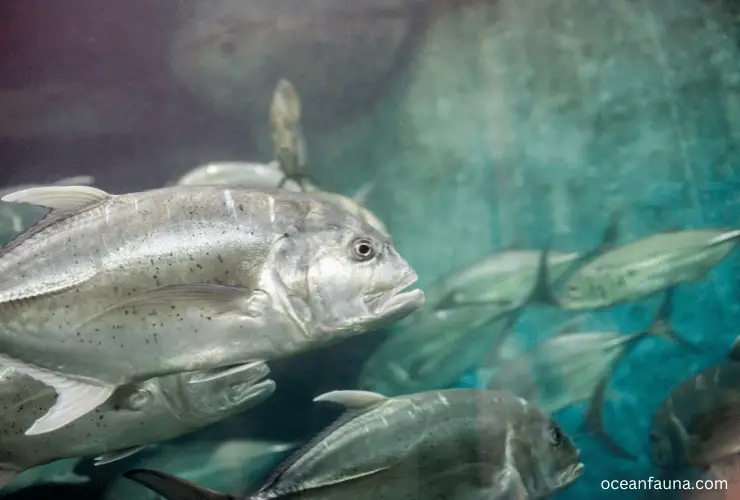
Digestive System:
Jack Crevalle has a simple digestive system with a mouth, pharynx, esophagus, and small intestine. The fish’s teeth are extremely sharp and help to shred food into small pieces, making it easier to digest. The stomach of Jack Crevalle is simple and lacks a clear boundary between it and the small intestine, allowing for rapid digestion.
Circulatory System:
The circulatory system of Jack Crevalle is a closed system consisting of a heart, arteries, veins, and capillaries. The heart of Jack Crevalle is a single-chambered structure that pumps blood throughout the body. The blood of Jack Crevalle is oxygenated as it passes over the gills and then travels to the rest of the body.
Respiratory System:
The respiratory system of Jack Crevalle is composed of gills, which are used to extract oxygen from the water. Jack Crevalle has four pairs of gills, which are protected by a bony cover. The gill filaments of Jack Crevalle are richly supplied with blood vessels, which enable efficient gas exchange.
Nervous System:
The nervous system of Jack Crevalle is composed of the brain, spinal cord, and peripheral nerves. The brain of Jack Crevalle is well-developed and is responsible for coordinating all the fish’s activities. The peripheral nerves of Jack Crevalle transmit information from the sensory organs to the brain and motor impulses from the brain to the muscles.
How Big is a Jack Crevalle?
The size of a Crevalle Jack can vary greatly, as they can reach up to 4 feet and 60 pounds. However, the average size range for this Jack species is between 12-24 inches in length and 3-5 pounds in weight, with females being larger than males.
[Fact: The maximum size recorded for a Crevalle Jack is 39.8 inches (101 cm) and 55.1 pounds (25 kg), although they are commonly found at a more modest size of 23.6 inches (60 cm).]
Once a juvenile Crevalle Jack reaches a size of 1.97 inches (5.0 cm), its growth rate increases dramatically. This means that Crevalle Jack can grow quite quickly, particularly when they are young.
Also, they are diurnal predators, meaning that they are most active during the day. This can make them a popular target for anglers who enjoy fishing during daylight hours.
In Texas waters, the average weight of a Crevalle Jack is between 2-5 pounds. However, larger sizes are also common in these waters, and Crevalle Jack’s not unusual to weigh up to 25 pounds. This speaks to the diversity of this species, as well as their ability to thrive in a variety of environments.
Where Does Jack Crevalle Live?
The crevalle jack, a fish species, is widely distributed across the tropical and temperate waters of the Atlantic Ocean. It can be found in several parts ranging from Nova Scotia, Canada, to Uruguay in the western Atlantic and from Portugal to Angola in the eastern Atlantic. Additionally, it inhabits the Mediterranean Sea.
Regarding habitat range, the crevalle jack prefers inshore and offshore waters. It is commonly found in shallow waters over reefs, bays, and lagoons, but it can also be found in deeper waters with depths of up to around 350 meters. In some instances, they even inhabit estuaries, which are habitats that are typically part saltwater and part freshwater.
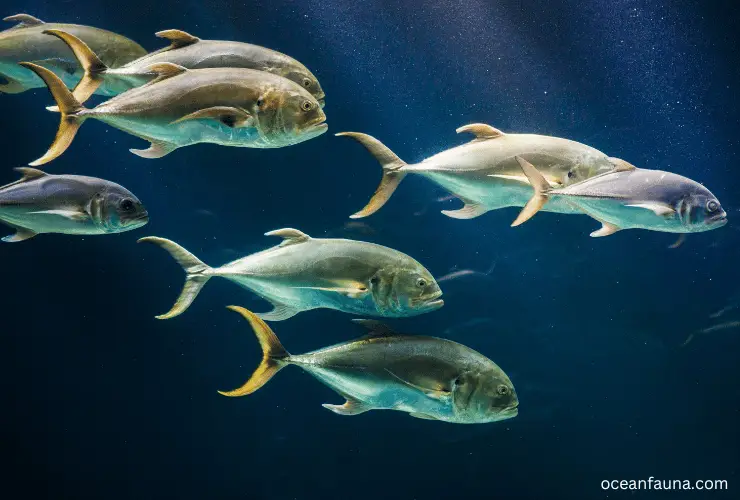
Several factors, including water temperature, nutrient availability, and the presence of potential prey, influence the crevalle jack’s habitat preferences. They tend to inhabit areas with high nutrient availability, which can support a diverse range of prey items for them to feed on.
What Does Jack Crevalle Eat?
Jack crevalle are known to be large, powerful, and aggressive predatory fish with a carnivorous feeding habit. They have a wide range of appetites and will feed on anything that comes their way.
However, they mostly prefer smaller-sized schooling fish such as pinfish, mullet, anchovies, Atlantic bumper, croaker, and mackerel, as these tend to be the bulk of their diet.
In addition to smaller fish, jack crevalle also enjoy feeding on crustaceans, invertebrates, and squid. These crustaceans often include small shrimps, crabs, and lobsters. They are also known to prey upon a variety of mollusks, such as squids, cuttlefish, octopuses, and other small invertebrates that come their way.
Interestingly, jack crevalle has been known to eat small mammals too. They have been known to feed on small rodents such as mice, shrews, and voles, which they catch when hunting in shallow waters.
How Long Does a Jack Crevalle Live?
The larval and juvenile growth of Jack Crevalle has been thoroughly researched, with the oldest known individual being 17 years of age. However, this information does not specify the lifespan of Jack Crevalle.
According to various scientific sources, Jack Crevalle (Caranx hippos) is a relatively short-lived fish species, with an average lifespan of around ten years in the wild.
However, the exact lifespan of Jack Crevalle may vary depending on various factors such as food availability, habitat, and predation. Additionally, some populations of Jack Crevalle may have longer or shorter lifespans than others due to distinct environmental conditions.
Moreover, it is significant that Jack Crevalle is a fast-growing fish species, with juveniles reaching up to 8 inches in a year. This fast growth rate may compensate for the shorter lifespan, allowing individuals to reach maturity quickly and contribute to the population’s reproductive success.
How does Jack Crevalle Reproduce?
The jack crevalle reproduces through external fertilization, where females lay over a million eggs outside their bodies, and males fertilize them by releasing their sperm into the water. This fish species is oviparous, meaning the eggs hatch outside the female’s body.
Jack crevalle is an iteroparous species, meaning it can reproduce several times throughout its life. Sexual maturity in this species occurs at different lengths for males and females, and their age of maturity also varies.
Male crevalle jacks achieve sexual maturity at approximately 55 cm in length and four to five years of age, while females reach maturity at around 66 cm and five to six years of age.
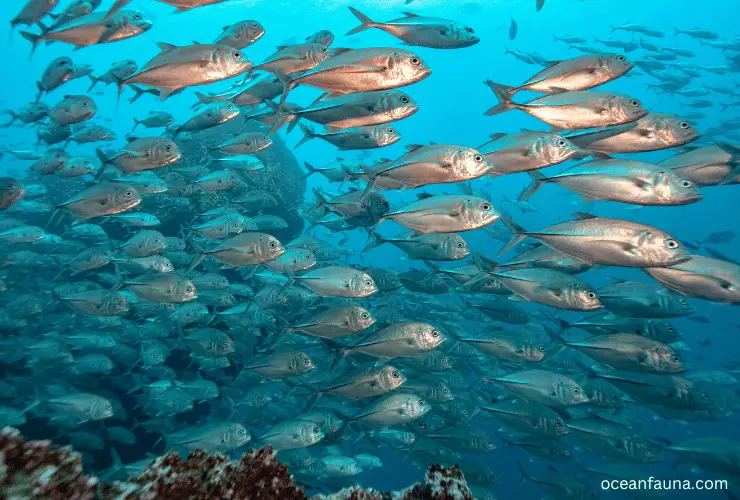
Reproduction in jack crevalles is thought to occur year-round in most areas; however, there are different peaks in activity depending on the region. For example, in South Florida, the peak period for reproduction is between March and September, while in Cuba, it occurs in April and May.
During the spawning season, males and females form schools, and the males become more aggressive, chasing and nudging females to release eggs. The eggs are then fertilized and hatch into larvae within a few days, depending on the water temperature.
The larvae are usually planktonic, drifting with the current and feeding on small organisms until they become juveniles and can feed on larger prey.
Is Jack Crevalle Dangerous?
Despite their reputation as strong fighters, Jack Crevalle is not considered dangerous to humans. In fact, as long as you take the necessary precautions and respect their space, there is little reason to fear them.
One important factor to keep in mind when encountering Jack Crevalle is that they tend to be territorial fish. Therefore, if you are swimming or diving in an area where they are known to reside, it is important to keep your distance and avoid disturbing them. This can help prevent unwanted confrontations and keep you and the fish safe.
Additionally, Jack Crevalle are not poisonous fish like some other species, such as the Japanese pufferfish. While it is always important to exercise caution when handling any type of sea creature, there is no need to worry about accidentally ingesting any harmful toxins from a Jack Crevalle.
Is Jack Crevalle Fish Edible?
Yes, jack crevalle is edible. However, it is not widely considered a desirable fish for consumption due to its poor taste and flavor. Most anglers agree that jack crevalle is of poor-quality regarding taste.
If you do decide to eat jack crevalle, it is recommended that you prepare it in a specific manner.
Firstly, the fish must be bled and filleted in a specific way. This is important as it removes excess blood and oils that can make the fish too fishy to eat. Secondly, jack crevalle can be eaten raw but is often prepared as ceviche or sashimi.
Some people may experience a reaction to consuming jack crevalle due to its high levels of histamine. This is more commonly found in fish that have been improperly stored or handled. Therefore, ensure that the fish is fresh and properly prepared to reduce any potential risks associated with consuming it.
What Is the Conservation Status Of Jack Crevalle?
According to the 2018 assessment on The IUCN Red List of Threatened Species, the conservation status of Jack Crevalle, scientifically known as Caranx hippos, is classified as Least Concern. This indicates that the species is not considered to be at significant risk of extinction at the current time.
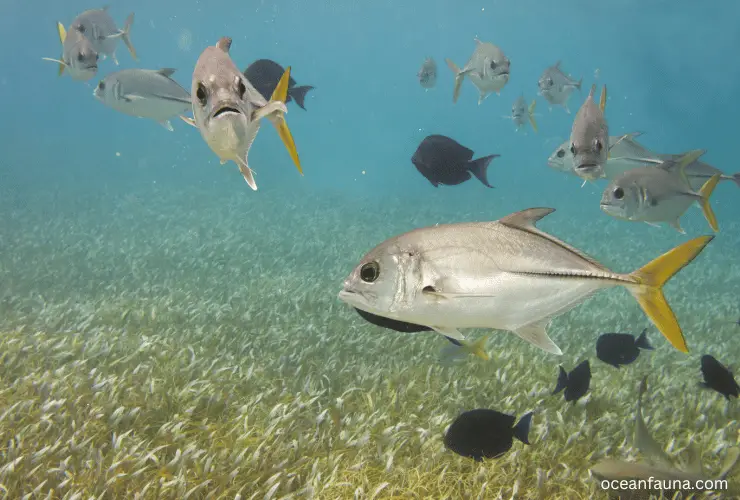
Jack Crevalle is a widely distributed fish species that can be found in the tropical and temperate waters of the Atlantic Ocean, including the Gulf of Mexico, the Caribbean Sea, and off the eastern coast of South America. It is known for its powerful swimming abilities and is an important game fish for recreational fishing in many parts of its range.
Despite its popularity in recreational fishing, there are no significant threats to the survival of the Jack Crevalle population. It is a fast-growing species that is highly adaptable to a range of environmental conditions, and its populations are not currently experiencing any significant declines.
Conclusion
Hopefully, now you have a compact knowledge of Jack Crevalle. This fish species is a popular game fish in many parts of its range and is a relatively short-lived but fast-growing species. Its conservation status is classified as Least Concern.
Ask me if you want to know more about this aggressive ocean creature.

